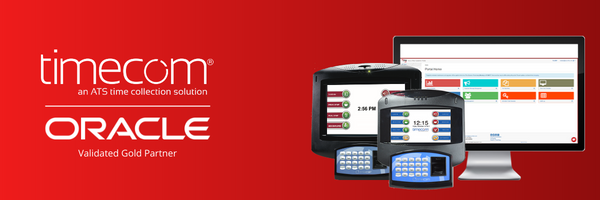Time and attendance policies are essential for managing productivity and workforce dynamics. To optimize workforce management, organizations rely on solutions like Oracle Cloud Time and Labor as their time and attendance software application.
Without these effective tools, businesses risk stagnation and losing their competitive edge.

Improve Workforce Efficiency by Gaining Insights into Attendance Trends
Using a WFM tool like Oracle Time and Labor with a time clock system, like the PeoplePoint Plus from Accu-TimeSystems, provides attendance and time data you need. Managers and WFM can use the complete data sets to analyze attendance policies and enhance workforce efficiency.
When integrated properly, the time clock system automates time recording and managing work hours, replacing manual or old time card systems. It can also collect additional employee data information, such as department or role.
Managers can use the data to improve employee schedules and avoid conflicts and infractions. They can identify employees who are often late or absent for early intervention.
Promote Employee Dialogue with Management
Clear communication of the company's attendance policy is pivotal to its fair  enforcement. Employees should understand why they must punch in at every shift and break. Let them know that managers monitor their attendance by examining the time clock data.
enforcement. Employees should understand why they must punch in at every shift and break. Let them know that managers monitor their attendance by examining the time clock data.
This awareness can motivate employees to communicate with managers more frequently about potential scheduling conflicts or absences.
Managers can use attendance info to talk to employees about improving scheduling or their attendance.
TimeCom allows management to send messages directly to their employees via the time clock, facilitating-dialogue and transparency between employees and their supervisors.
Simplify Compliance Management with an Oracle Time and Labor Time Clock
Time and attendance policies, supported by tools like Oracle Cloud Time and Labor, time clocks and payroll software, are essential to managing compliance with wage and hour laws and other legal requirements.
By using Oracle Time and Labor with an integrated time clock system, WFM or payroll teams can analyze hours worked data to find compliance risks so they can be addressed immediately.
ATS's TimeCom is an advanced time clock system that ensures compliance with policies and legal requirements through rule-based time recording.
An advanced time clock system, like ATS’s TimeCom, improves compliance with attendance policies and legal requirements through rule-based time recording.
For example, you can configure TimeCom to:
Using Oracle's solutions simplifies compliance with laws, protecting the company from penalties for overtime and scheduling issues.

Motivate Employees to Adhere to the Schedule
When managers ignore poor schedule adherence, employees know they’re in an undisciplined work environment. Managers with the tools to enforce time and attendance policies can hold employees accountable for their attendance record.
A well-structured and disciplined workplace ensures that tasks are completed on time, which enhances operations. When employees follow their schedules diligently, they contribute to a more predictable workflow. Managers can use this predictability to reduce disruptions and improve forecasting, allowing them to allocate resources better.
Raise Employee Satisfaction
Employees want to understand what management requires of them. Clear time and attendance policies communicate achievable expectations.
The policies, and software tools that enforce them, should provide guidelines for addressing common situations, such as how to:
- Submit time off requests and the manager's role in approving time-off
- Talk to managers about an unavoidable schedule conflict or emergency absence.
Employees who are happy with their schedule and see managers following company policy are more satisfied with their work experience. Happier employees lead to greater retention and improved productivity.
Support Company Growth with Effective Attendance Management
Time and attendance policies, along with supporting systems, are crucial for improving company competitiveness and financial health. Look for cloud based workforce management tools, like Oracle Cloud Time and Labor, and time clock systems like ATS’s TimeCom.
Having consistently enforced time and attendance policies helps companies stay competitive in fast-changing markets and improves employee satisfaction.
Check out other Time and Attendance Resources:
What You Need to Know about Stopping Time Theft and Buddy Punching
Why Payroll Processing begins at the Time Clock
Should I use my Mobile App or Web Clock for Time and Attendance?
Get in touch with our solution consultant today for all your time and attendance needs.









